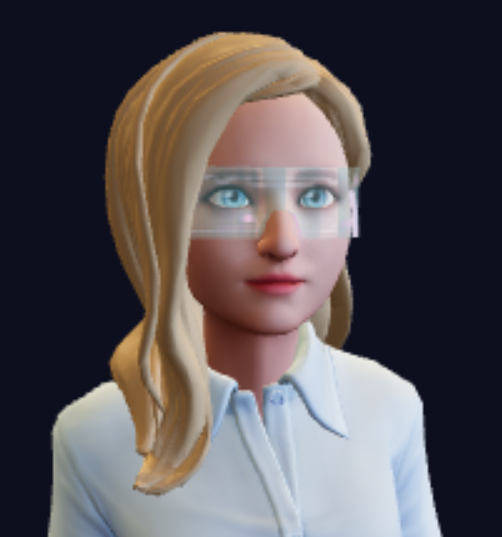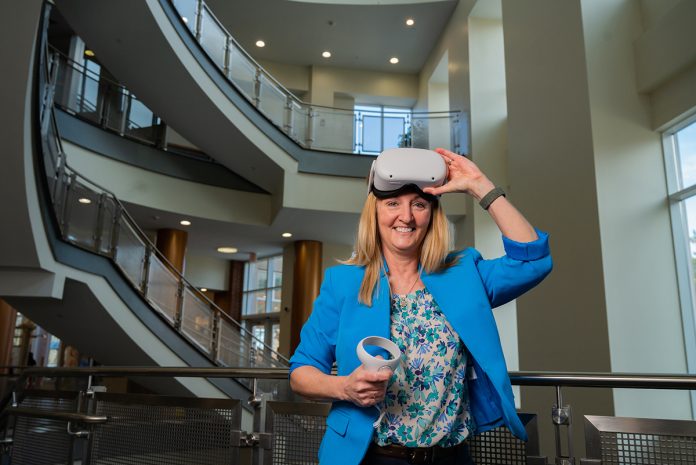Advances in development of and access to technology have helped open the door to new, exciting experiences across various disciplines in the educational field. No longer must a student sit in a classroom or read from a physical textbook to learn. Videos, online games, guided virtual tours, and immersive content occupy today’s educational landscape — offering new and exciting ways for students to learn the past, present, and future.
“Imagine, instead of reading about the ancient Egyptian pyramids, we can take you there, have you walk around them, and then take a peek inside,” said Colleen Bielitz, Southern’s associate vice president for strategic initiatives and outreach. “The immersion provides a deeper understanding than reading static pages of a textbook.”
The driving force behind the hopeful introduction of meta to Southern, Bielitz paints a truly futuristic picture of how the metaverse could be utilized in the future of Southern’s educational landscape.
“[The Metaverse] will be a simulated digital environment that harnesses the power of current technologies such as augmented reality (AR), virtual reality (VR), and blockchain — in tandem with social media spaces — to create environments that are rich, immersive, and interactive,” said Bielitz.
Bielitz’s role requires her to constantly stay ahead of trends, using an amalgamation of research and data to predict technology’s future, conceptualize futuristic ideas, and quickly implement them.
To say she is fully immersed still somehow wouldn’t capture it. Bielitz is currently a co-lead for the education committee for VRARA and a co-lead for the XR committee for Educause. She is also a member of XR Women, Women in AI (Artificial Intelligence), Connecticut Higher Ed Economic Development Working Group, and CT NEXT Higher Education Entrepreneurship Advisory Committee. In addition, Bielitz is an active participant in economic panels and conferences discussing advances in VR, its impact on business and how it can play a role critical role in the future of education.

Meta Platforms Inc., the parent company of Facebook, has made platforms like the metaverse the center of its push to the future of technology. Since purchasing Oculus, a virtual reality headset company, in 2014, Meta has taken significant steps toward launching its immersive online platform.
In 2021, the company kept its promise of going “all in” on the metaverse by spending 10 billion dollars in just one year of development, as reported by the New York Times, with plans to spend more money in the future in the hopes of having a fully developed metaverse between 2022 and 2025, VentureBeat Reports.
The origins of the metaverse are not exclusive to Zuckerberg. The idea came from the 1992 novel Snow Crash, where author Neal Stephenson coined the term. In his book, Stephenson envisions the metaverse as a digital successor to the internet, replacing it with the virtual-reality-based world. The replacement would allow users to create digitized, completely customizable versions of themselves, which they would use to build a new life, communicate, and explore the vast opportunities and experiences offered through an alternate reality.
Today’s version of the metaverse, while similar in concept, is slightly more technical and nuanced than described in Stephenson’s novel 30 years ago. Although virtual reality has been around since the 1990s, barriers such as cost, limited use, and lack of development have hindered its growth.
“As an educational institution preparing our graduates for the future, we need to stay ahead of the curve. As technology advances to bring us new immersive and imaginary worlds, how we educate children and prepare teachers must also advance to meet these opportunities,” said Bielitz
While younger students can utilize the metaverse to better visualize and interact with basic concepts, Bielitz would like to see designated courses at Southern that not only enhance students’ learning of assigned course material, but showcase and better educate students on new opportunities for their desired fields, providing training and building experience with virtual and augmented reality applications.
While projected advances in the metaverse’s development and capabilities address some of the barriers that prevented its growth years prior, there are still glaring barriers to entry such as cost, student and institutional access, integration, and moderation that need to be addressed.
“The infrastructure is still under construction,” Bielitz said. “In addition, there are no seamless technologies to use that work across different platforms, there is no central marketplace to find educational tools, and there are privacy vulnerabilities and equity issues. There is also a great need for research on the efficacy and best practices.”
Though the concept is still in the works, there is a lot of promise for its implementation at Southern and across the education field – blowing some fresh air into an otherwise routine discipline.
“It can make education opportunities more widespread and accessible by providing limitless possibilities regarding how subjects are taught,” Bielitz said.


